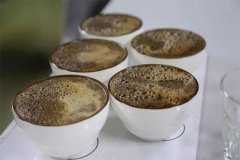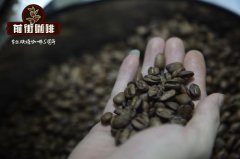One of the factors affecting coffee how does water quality affect coffee extraction?
More fine coffee beans please add
Private WeChat Front Street, WeChat:
(long press copy)
qiannjie
01 |preface
We know that the main factors affecting coffee are origin, roast, grind, water temperature, proportion, brewing method, freshness, and water quality. No matter what kind of factors, all of them are scientific to study the influence of various factors on coffee flavor, and they must return to the essence. And our research method is generally to use a single variable method to understand the impact of certain factors.
How does water affect coffee? The reason why I want to study coffee extraction around water quality in this article is as follows:
A cup of coffee is about 99% water, and only 1% of coffee can make the whole cup of coffee change dramatically. Most people think that water only acts as a carrier and has little effect on coffee flavor.
The influence of this factor on water quality is more difficult than other factors. It looks the same water and cannot be recognized by the naked eye.
Most people don't pay attention to the impact of water is the main reason why I write about water quality.
02| Know the water.
I believe most people have experienced drinking sweet water. So the question arises, why does pure water taste a little sweet?
Here is what I think I agree with:
In fact, the water treated by the pure water machine (built-in reverse osmosis membrane) will not have any taste. To be precise, it should be odorless. Many people think that the treated water has a "sweet" taste, in fact, it should be that the original drinking water contains too many impurities, taste or smell, long-term so, affecting the taste buds on the taste of the water accurate discrimination.
In this case, the drinking water suddenly becomes a lot cleaner. This contrast is the fundamental reason why you feel that the water has a sweet taste. The reason is so simple.
Before understanding water, you need to understand the factors that affect water quality: TDS , hardness (GH), pH (pH).
Hardness (GH)
Soft water:
Water that does not contain or contains less soluble calcium and magnesium compounds is called soft water.
Hard water:
Hard water refers to water containing more soluble calcium and magnesium compounds.
TDS:
Also known as total dissolved solids, the higher the TDS value, the more dissolved substances contained in the water, including both inorganic and organic substances, measured in mg/L.
A unit of concentration in parts per million of PPM solution. The number of milliliters of solute contained in 1 million milliliters of solution or the number of grams of solute contained in 1 million grams of solution.
Conversion relationship: 1mg/l=1PPM
PH:
Also known as hydrogen ion concentration index: A scale of hydrogen ion activity in a solution, that is, a measure of the acidity of a solution in the usual sense.
03| How water affects coffee extraction
According to coffee extraction theory, we know that
When the TDS is too high, the minerals in the water are supersaturated and there is not enough room to extract the flavor from the coffee (mentioned in Water for Coffee);
The TDS value is too low, and the penetration capacity of water may not be enough, resulting in insufficient extraction.
Previously I thought that the lower the TDS, the theoretically easier it was to extract. Why is it that facts tend to cause underextraction?
Crucially, some of the compounds in hard water are "sticky," and they cling to compounds in coffee during coffee making. Calcium and magnesium are particularly viscous, and coffee has a stronger taste and higher caffeine content if the water contains a lot of magnesium ions. Hard water, however, also has more carbonate, which Hunton found may be the source of coffee's more bitter taste. Soft waters tend to have a lot of sodium, but they don't have viscosity (which doesn't help extract either the good or bad ingredients of coffee).
SCA studies show that ppm values of water between 125 and 175 are ideal for extracting coffee, ppm values below 75 are more likely to be over-extracted, and ppm values above 225 are more likely to be under-extracted.
Summary: TDS affects coffee extraction relatively, depending on the proportion of good ingredients in your water that are beneficial to coffee extraction. (For example, the TDS value is low, and the content of calcium and magnesium ions is mostly conducive to extracting coffee)
04| test verification
Test equipment:
Qu XX brand distilled water, a little sweet mountain spring, smart cup, TDS detection pen.
Reasons for selection: distilled water is the most extreme soft water, does not contain any substances, more contrast; a little sweet spring TDS value is low, but the calcium and magnesium content is relatively high, in line with the theory is conducive to extracting coffee basis; smart cup immersion extraction can reduce the experimental error caused by the method.
TDS Test:
Distilled water:
A little sweet mountain spring:
Sweet Soluble Matter Data:
Brewing data:
Test coffee beans: Sunlight 90+ candle shine (Roast date 5.19)
Brewing method: Hand brewing
Abrasion: 4W(BG)
Smart cup, 18 grams of powder, water temperature 90 degrees, water powder ratio close to 1:16
45 grams of water stewed for 20s,
After injection to 288ml, the total time is 3 minutes.
Test Group 1 (distilled water):
Flavor Description:
The wet fragrance is floral, slightly berry fruity, with obvious citrus acid in the entrance, citrus sweet, clean taste, general alcohol, flavor concentrated in the front interruption, with a slight sweetness at the end, no obvious sun bean characteristics, more like washed beans.
Sweetness: † †
Acidity: ☆☆☆
Bitterness: ☆
Degree of maturity: ☆☆
Test group 2 (mountain spring water):
Flavor Description:
The sour feeling is relatively weak, the sugar is sweet in the mouth, the honey is sweet, the taste is thick with a sense of weight, the taste is clean and the aftertaste is long, and the overall feeling is comfortable and pleasant.
Sweetness: † † † †
Acidity: † † †
Bitterness: ☆
Weight: ☆☆☆
Comparative conclusion:
The acid content of coffee washed out by mountain spring water is lower than that of distilled water, but the sweetness is much higher, and the body performance is almost perfect, including the aftertaste.
Distilled water rushed out of the coffee is not as inadequate as I imagined, as if the extraction of coffee before the interruption, it shows a strong acid feeling, sweetness, clean and bright also have a different flavor, and spring water rushed out of the coffee acid is relatively weak because it is excellent sweetness overshadowed it has acid, but spring water rushed out of the coffee thick with a sense of weight, sweetness is high, but also shows that the extraction rate of spring water is higher than distilled water, This also proves that relatively low TDS and having viscous dissolved matter are more conducive to the conclusion of coffee extraction.
05| end
As for the influence of water quality on coffee, the conclusion of this paper may only be applicable to the embodiment under certain conditions, and the conclusion may be one-sided and correct. But that's the fun of coffee. We test our doubts, we learn, we learn.
Important Notice :
前街咖啡 FrontStreet Coffee has moved to new addredd:
FrontStreet Coffee Address: 315,Donghua East Road,GuangZhou
Tel:020 38364473
- Prev

History of Panama
Coffee was introduced to Panama in 1780, when Europeans brought in the first Typica species. The history of Panamanian coffee begins. For Panamanians at the time, the drink was both novel and mysterious, and not only quickly conquered people's consciousness, but also caused the locals to start growing coffee trees in general. Riding the third wave of coffee aesthetics
- Next

What are the changes of soft beans, sun beans or low-altitude beans during baking?
Professional coffee knowledge exchange more information about coffee beans Please follow the similar changes in the roasting process of sun-dried beans, soft beans or low-altitude beans in the coffee workshop (Wechat official account cafe_style). I put them into the same group. Because the treatment time of sun-dried beans is longer than that of washed beans, and the relative moisture content is relatively low, especially in the part of the bean surface, so it is in the process of baking.
Related
- Beginners will see the "Coffee pull flower" guide!
- What is the difference between ice blog purified milk and ordinary milk coffee?
- Why is the Philippines the largest producer of crops in Liberia?
- For coffee extraction, should the fine powder be retained?
- How does extracted espresso fill pressed powder? How much strength does it take to press the powder?
- How to make jasmine cold extract coffee? Is the jasmine + latte good?
- Will this little toy really make the coffee taste better? How does Lily Drip affect coffee extraction?
- Will the action of slapping the filter cup also affect coffee extraction?
- What's the difference between powder-to-water ratio and powder-to-liquid ratio?
- What is the Ethiopian local species? What does it have to do with Heirloom native species?

